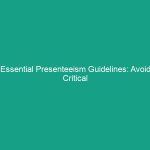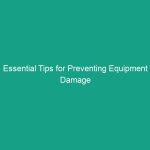Good Morning Team!
Today, we are going to discuss an important topic: Essential Guidelines for Preventing Equipment Damage Incidents Effectively. Understanding how to prevent equipment damage is vital for our Workplace Safety, productivity, and overall success. By following these guidelines, we can not only protect our tools and machinery but also ensure a safer working Environment for everyone.
Understanding Equipment Damage Prevention
Equipment damage prevention refers to the strategies and practices designed to minimize the risk of harm to our tools, machinery, and equipment. This is crucial not only for maintaining operational efficiency but also for ensuring the Safety of all employees involved in the processes. When equipment is damaged, it can lead to downtime, costly repairs, and even potential Hazards for workers.
One of the common misconceptions is that equipment damage primarily occurs due to wear and tear. While that is a factor, many incidents arise from improper usage, lack of Maintenance, or failure to follow Safety protocols. Understanding these aspects can significantly reduce the chances of equipment-related incidents.
Key Hazards, Risks, and Safety Considerations
When it comes to equipment damage, several hazards and risks can arise:
- Improper Use: Using equipment for purposes it wasn’t designed for can lead to malfunctions or failures.
- Lack of Maintenance: Failing to perform regular inspections and maintenance can result in equipment breakdowns.
- Environmental Factors: Exposure to harsh environments can deteriorate equipment more quickly.
- Negligence: Not following safety protocols can lead to accidents that damage equipment.
The consequences of ignoring these risks can be severe. For instance, a simple oversight in equipment handling can result in costly repairs, increased downtime, or even accidents leading to injury. Recognizing these risks is the first step toward prevention.
Best Practices, Procedures, & Actionable Advice
Now, let’s dive into some practical steps we can take to prevent equipment damage:
1. Proper Training
Ensure that all employees are adequately trained on how to use equipment safely and effectively. This includes understanding operational Procedures and recognizing potential hazards.
2. Regular Maintenance
Establish a routine maintenance schedule for all equipment. Regular checks can identify issues before they escalate into serious problems. Always keep maintenance logs to track repairs and inspections.
3. Use Equipment as Intended
Always use equipment for its intended purpose. If you are unsure, refer to the user manual or ask a supervisor. Misusing equipment can not only lead to damage but also pose serious safety risks.
4. Conduct Safety Inspections
Before using any equipment, perform a quick safety inspection. Check for any visible damage, loose connections, or signs of wear. If you find anything concerning, report it immediately.
5. Keep Work Areas Clean
A cluttered workspace can lead to accidents. Ensure that all areas where equipment is used are kept clean and organized to minimize hazards.
6. Use Personal Protective Equipment (PPE)
Wearing appropriate PPE such as gloves, goggles, and helmets can protect you from potential hazards associated with equipment use.
7. Learn from Incidents
If an incident occurs, take the time to analyze what happened. Discuss it as a team, and learn how to prevent similar occurrences in the future.
Regulations, Standards, and Compliance
It’s essential to be aware of Regulations set forth by organizations like OSHA (Occupational Safety and Health Administration) and ISO (International Organization for Standardization). Compliance with these Standards not only keeps employees safe but also protects the integrity of our equipment.
Failing to adhere to these guidelines can lead to significant consequences, including fines, legal issues, and increased risks of accidents. Therefore, understanding and following these regulations is critical to our operations.
Employee Engagement & Discussion
Now, let’s open the floor for discussion. I want to hear from you:
- What safety challenges have you encountered related to equipment use?
- Are there any specific procedures you think we could improve upon?
- Have you seen equipment damage incidents in the past that could have been prevented?
Feel free to share your experiences or suggestions. Remember, safety is a shared responsibility, and your input is valuable.
Conclusion & Key Takeaways
In summary, preventing equipment damage incidents is a crucial aspect of maintaining a safe and efficient workplace. By focusing on proper training, regular maintenance, and adhering to safety protocols, we can significantly reduce the risk of incidents.
Let’s commit to applying these guidelines in our daily operations. Remember, prioritizing safety protects not only our equipment but also each other. Thank you for your attention, and let’s continue to work together to maintain a safe working environment!


